
Hypselodoris cantabrica
Bouchet & Ortea, 1980
Order: NUDIBRANCHIA
Suborder: DORIDINA
Superfamily: EUDORIDOIDEA
Family: Chromodorididae
PHOTO
4-5 cm, France, Bassin d'Arcachon (Bay of Biscay), divesite "St. Yves", nightdive 1997, depth unrecorded. PHOTO: Michel Barrabés
See message below.
-
Bouchet, P. & Ortea, J. (1980) Quelques Chromodorididae bleus (Mollusca, Gastropoda, Nudibranchiata) de l'Atlantique oriental. Annales de l'Institut Oceanographique, Paris, 56(2): 117-125.
-
Ortea, J., Valdés, Á. & García-Gómez, J.C. (1996) Revisión de las especies atlánticas de la familia Chromodorididae (Mollusca: Nudibranchia) de grupo cromático azul. [Review of the Atlantic species of the family Chromodorididae (Mollusca: Nudibranchia) of the blue chromatic group.] Avicennia. Revista de Ecologia y Oceanologia y Biodiversidad Tropical. Supplement 1. 165pp.
Rudman, W.B., 2000 (March 19) Hypselodoris cantabrica Bouchet & Ortea, 1980. [In] Sea Slug Forum. Australian Museum, Sydney. Available from http://www.seaslugforum.net/find/hypscant
Related messages
Hypselodoris cantabrica and parasite
September 8, 2007
From: Joao Pedro Silva
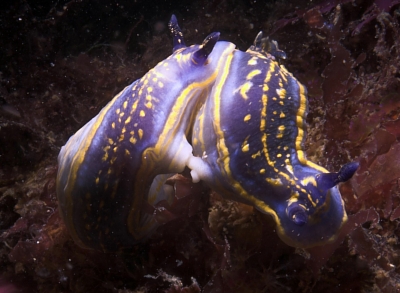
Dear Bill,
Yesterday I had the most productive dive ever. At least 10 species of nudibranchs were observed plus the more commonly found Aplysia fasciata and Aplysia punctata.
Locality: Peniche, 10 metres, Portugal, North Atlantic, 02 September 2007, Rocky bottom. Length: 3cm. Photographer: Joao Pedro Silva.
While looking at the photo of a pair of large Hypselodoris cantabrica mating I saw two small copepod parasites, one on the gills and the other next to the genital opening of the individual on the right. This was the first time I noticed these small creatures and I'm considering reviewing all of my previous photos (ok, most of them) to see if there are more parasites around.
Cheers,
Joao Pedro Tojal Loia Soares Silva
jpsilva@uwphotographer.net
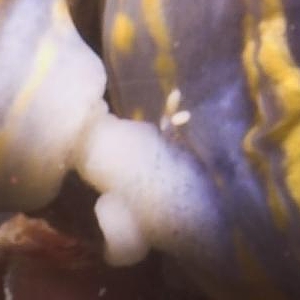
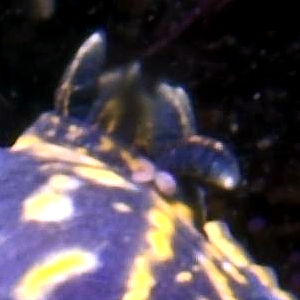
Thanks Joao Pedro,
The paired egg sacs of these little copepods certainly stand out.
Best wishes,
Bill Rudman
Hypselodoris cantabrica laying eggs.
June 17, 2006
From: Joao Pedro Silva
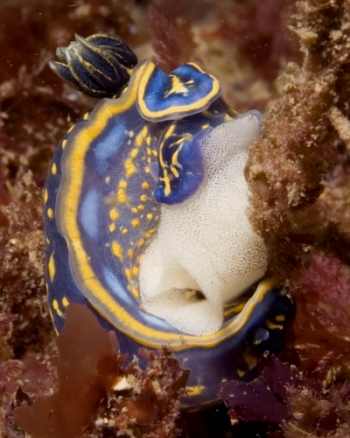
Dear Bill,
Last Saturday I shot this fairly large Hypselodoris cantabrica laying eggs. It was inside a crevice in the rock at aproximately 7 meters deep and it required a change on my strobe's position to get to the animal.
Locality: Baleal, 7 meters, Portugal, Atlantic Ocean, 10 June 2006, rocky bottom. Length: aprox. 4cm long. Photographer: Joao Pedro Tojal Loia Soares Silva.
Quite a common species around these parts but still a first for me to see it laying eggs. Several dozen of its "cousins", Hypselodoris villafranca were mating that same day not far from that rock [see separate message #16878 ]
Cheers,
Joao Pedro
jpsilva@uwphotographer.net
Silva, J. P., 2006 (Jun 17) Hypselodoris cantabrica laying eggs.. [Message in] Sea Slug Forum. Australian Museum, Sydney. Available from http://www.seaslugforum.net/find/16873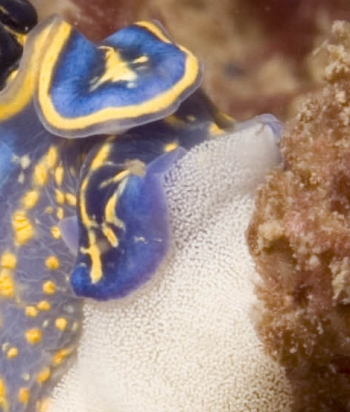
Dear Joao Pedro,
Thanks for the photo. As I have said before [message #14740] I have some difficulties separating H. cantabrica from H. malacitana, so unlesss someone objects I will use your identification. The egg ribbon certainly looks like others we have on the Forum of this species.
Best wishes,
Bill Rudman
Hypselodoris malacitana or H. cantabrica?
September 13, 2005
From: David Abecasis
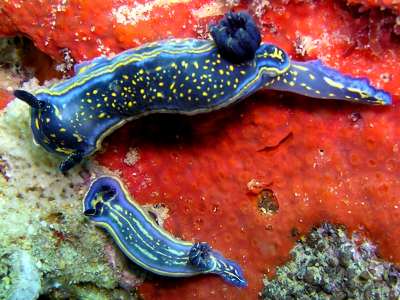
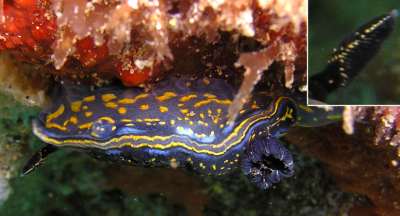
Dear Bill,
Concerning your comments to my last message [#14719], I have more photos, from some other animals but I'm not sure if they are the same species. These were also taken in Algarve (South Portugal).
Locality: Faro, Algarve, Portugal. Depth: 12 metres. 29 June 2005. Photographer: David Abecasis
Best regards,
David Abecasis
davidbecas@netcabo.pt
Abecasis, D.A., 2005 (Sep 13) Hypselodoris malacitana or H. cantabrica?. [Message in] Sea Slug Forum. Australian Museum, Sydney. Available from http://www.seaslugforum.net/find/14740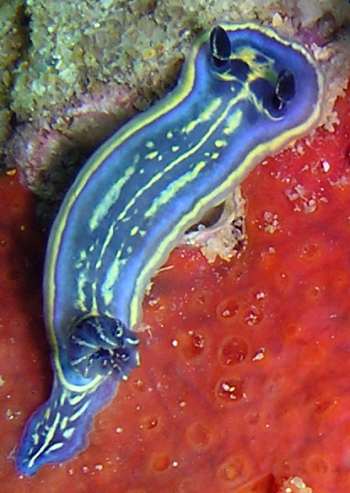
Dear David,
Thanks for the extra photos. I have had another look at the revision by Ortea, Valdes & Garcia-Gomez (1996) on these blue chromodorids and find it all a bit puzzling. What I did note is that they consider H. malacitana is only known from the Mediterranean coast of southern Spain while H. cantabrica is found on the Atlantic coast. if that is a real distribution, then your animal should be H. cantabrica. There are very few distinguishing features I can see from their account. The only direct comparison I can find in their work of the two species is that H. cantabrica had unicuspid jaw rodlets and H. malacitana has bicuspid rodlets, however these can differ in different parts of the jaw plates and in fact in Fig 82 it looks as though both types are present in the jaw plate of the H. malacitana specimen they illustrate. As I mentioned in your last message [#14719], they describe the rhinophore of H. malacitana having an inverted yellow Y down the posterior midline. I also note that they consider a T shaped yellow mark between the rhinophores to be important in H. cantabrica. In the photo alongside, your animal has the T shape of one species and the inverted Y shape of the other!
It gets even more complicated when they say elsewhere in the revision that H. bilineata has these same inverted Y rhinophore markings, and that juvenile H. malacitana can have a double white line down the dorsal midline, which is the distinguishing feature of H. bilineata. It seem to me we need to know more about about populations of these animals and their biology. It is certainly complicated by the fact that at least some of these species appear to be mimicking each other, but at present it seems we still have to determine just how many species there actually are.
On reflection, I think we should identify your animals as Hypselodoris cantabrica. I would very much like some comments from local experts.
Best wishes,
Bill Rudman
Hypselodoris cantabrica? from Portugal
September 13, 2005
From: David Abecasis
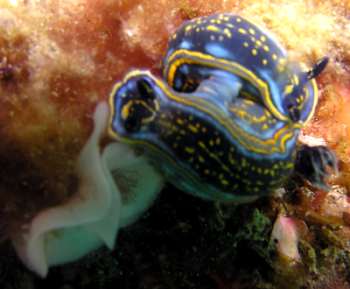
To accompany my other message [#14740] here are two animals mating and laying eggs. Again I'm not sure if these ones are also Hypselodoris malacitana or H. cantabrica. As they are laying eggs I thought it could be interesting.
Locality: Faro, Portugal. Depth: 10 m. 12 July 2005. Photographer: David Abecasis
Best wishes,
David Abecasis
davidbecas@netcabo.pt
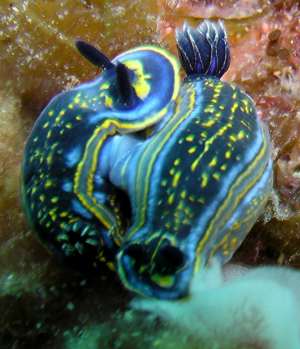
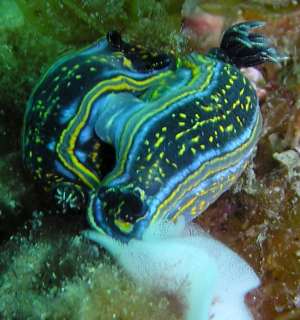
Thanks David,
As I said in your other message I now think this is Hypselodoris cantabrica. As to it laying eggs. They certainly aren't at the moment your photo was taken as they can't mate and lay eggs at the same time. However the egg ribbon certainly looks like one in an earlier message [#12746].
Best wishes,
Bill Rudman
Hypselodoris cantabrica feeding
December 24, 2004
From: Marina Poddubetskaia
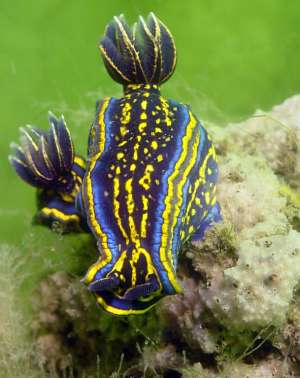
Dear Bill,
Three weeks ago I moved from Paris to Bordeaux, near the Atlantic coast. Now I can dive in Arcachon Basin every week-end, and as you know it, this place is full of sea slugs.
Now, we have a huge number of Hypselodoris cantabrica in the basin. They are everywhere invading their food sponge in large numbers.
I can see that on the Forum you have only one photo of this species. So, I assume you would like these photos of animals feeding, including the close-up of their sponge. Could you help me to identify this sponge, please ?
Date: August 01, 2004
Location: Cap Ferret, Bassin d'Arcachon, France, Atlantic coast
Site: Grand Piquey
Depth: 4-5m
Size: 35 - 55 mm
Photos: Marina Poddubetskaia - Nembro website
Best wishes,
Marina.
nembro@nembro.info
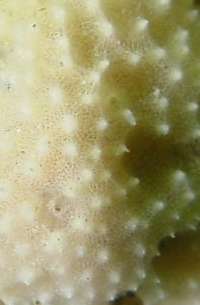
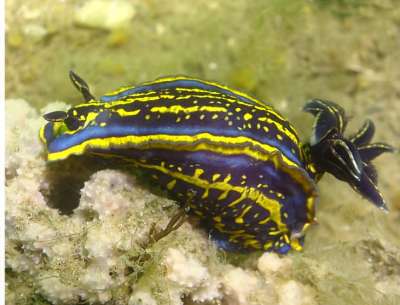
Thanks Marina,
This sponge food of this species is usually identified as Dysidea fragilis (Montagu) (see Bouchet & Ortea 1980, Avila 1995), but I have showed your photos to Dr Pat Bergquist, an expert in the group, who considers this to be Dysidea pallescens Schmidt, 1862. I don't know if this means this species feeds on both species of Dysidea, or if earlier observations on its food preference need checking. It is an interesting find. I look forward to further discoveries from Arcachon. Thanks also for the photos in your separate message [ #12746 ] of its egg ribbons.
-
Avila, C. 1995. Natural products of opisthobranch molluscs: a biological review. Oceanography & Marine Biology: an Annual Review 33: 487-559.
Best wishes,
Bill Rudman
Hypselodoris cantabrica egg-ribbons
December 24, 2004
From: Marina Poddubetskaia
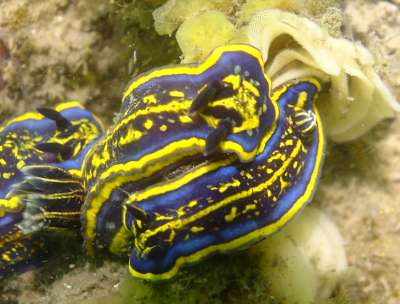
Dear Bill,
To complete my previous message [#12745] about Hypselodoris cantabrica, here are some photos of animals mating and their egg-ribbons. I think it is the spawning season for this species now because these eggs are as numerous as animals in here.
Date: August 01, 2004
Location: Cap Ferret, Bassin d'Arcachon, France, Atlantic coast
Site: Grand Piquey
Depth: 3-5m
Size: Length of animals: 35-40mm / Diameter of egg ribbons: 25mm.
Photos: Marina Poddubetskaia - Nembro website
Cheers,
Marina.
nembro@nembro.info
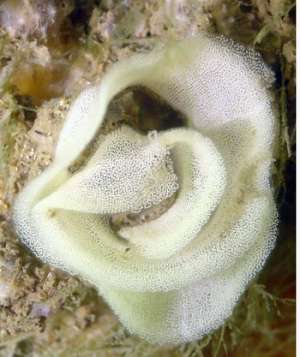
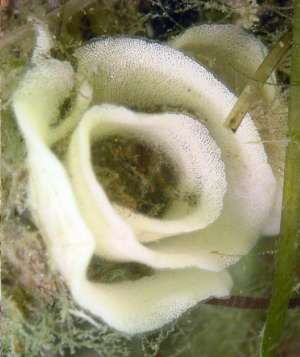
Thanks Marina
Bill Rudman
Photo of Hypselodoris cantabrica
March 19, 2000
From: Erwin Koehler

Hi Bill
Some days ago Sylvain Le Bris asked for a photo of Hypselodoris cantabrica Bouchet & Ortea, 1980. Here it is.
It was taken by Michel Barrabés, [Email michel.barrabes@wanadoo.fr]
Data: 4-5 cm, France, Bassin d'Arcachon (Bay of Biscay), divesite "St. Yves", nightdive 1997, depth unrecorded.
There are 2 more photos at http://www.medslugs.de/E/E-Atlantic/Hypselodoris_cantabrica.htm
Erwin
Medslugs.Koehler@t-online.de
Koehler, E., 2000 (Mar 19) Photo of Hypselodoris cantabrica. [Message in] Sea Slug Forum. Australian Museum, Sydney. Available from http://www.seaslugforum.net/find/2124Thanks Eric,
Bill Rudman.
